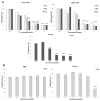Acridine-Based Chalcone 1C and ABC Transporters
- PMID: 40362377
- PMCID: PMC12071533
- DOI: 10.3390/ijms26094138
Acridine-Based Chalcone 1C and ABC Transporters
Abstract
Chalcones, potential anticancer agents, have shown promise in the suppression of multidrug resistance due to the inhibition of drug efflux driven by certain adenosine triphosphate (ATP)-binding cassette (ABC) transporters. The gene and protein expression of chosen ABC transporters (multidrug resistance protein 1, ABCB1; multidrug resistance-associated protein 1, ABCC1; and breast cancer resistance protein, ABCG2) in human colorectal cancer cells (COLO 205 and COLO 320, which overexpress active ABCB1) was mainly studied in this work under the influence of a novel synthetic acridine-based chalcone, 1C. While gene expression dropped just at 24 h, compound 1C selectively suppressed colorectal cancer cell growth and greatly lowered ABCB1 protein levels in COLO 320 cells at 24, 48, and 72 h. It also reduced ABCC1 protein levels after 48 h. Molecular docking and ATPase tests show that 1C probably acts as an allosteric modulator of ABCB1. It also lowered galectin-1 (GAL1) expression in COLO 205 cells at 24 h. Functional tests on COLO cells revealed ABCB1 and ABCC1/2 to be major contributors to multidrug resistance in both. Overall, 1C transiently lowered GAL1 in COLO 205 while affecting important functional ABC transporters, mostly ABCB1 and to a lesser extent ABCC1 in COLO 320 cells. COLO 320's absence of GAL1 expression points to a possible yet unknown interaction between GAL1 and ABCB1.
Keywords: ABCB1; ABCC1; ABCG2; chalcone; colorectal carcinoma; drug efflux; expression; galectin-1; multidrug resistance; transporter.
Conflict of interest statement
The authors declare no conflicts of interest. The funders had no role in the design of the study; in the collection, analysis, or interpretation of data; in the writing of the manuscript, or in the decision to publish the results.
Figures







References
MeSH terms
Substances
Grants and funding
- VEGA 1/0446/22/Grant Agency of the Ministry of the Education, Science, Research and Sport of the Slovak Republic
- VVGS-2023-2754/VVGS UPJŠ 2024-2025 Interdisciplinary Research Projects for University Teachers, Researchers Under 35, and PhD Students
- 857560/European Union's Horizon 2020 Research and Innovation Programme
- 101136607/European Union's Horizon 2020 Research and Innovation Programme
- LX22NPO5102/National Institute for Cancer Research (Programme EXCELES)
LinkOut - more resources
Full Text Sources
Research Materials

